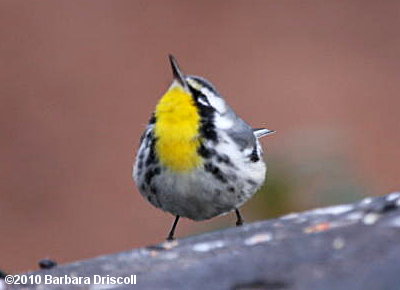
This Yellow-throated Warbler appeared the day before the count in Tom and Barbara Driscoll's yard in suburban Chapel Hill and was seen again on count day.

Barbara Driscoll took these photos of the bird on Jan. 3, 2010.
Yellow-throated Warbler on the 2009 Chapel Hill CBC!  This Yellow-throated Warbler appeared the day before the count in Tom and Barbara Driscoll's yard in suburban Chapel Hill and was seen again on count day.  Barbara Driscoll took these photos of the bird on Jan. 3, 2010. |
The Chapel Hill Christmas Bird Count on Sunday, 27 December 2009, produced 81 species, the lowest count in twelve years (10-year average 90.6). Weather for the count was fine, maybe too fine. This was the first nice day after a period of cold, wet weather and the birds seemed to be resting, enjoying a day off. Most participants remarked that bird activity was unusually low. In fact, only one counter, Derb Carter, reported having a good count. The total of 11011 individuals (10-year average 16634) is the lowest since 1996. In part this is because the level of participation in the count was far below normal, with the lowest number of counters since 1995 and only 125.5 party-hours compared to an average of 144.7. Even taking into account the low turnout, though, the 91.4 birds per party-hour (average 115) is the lowest since 1997. The birds just weren't very active and no big flocks of blackbirds, robins, or gulls were found.
The highlight of the count was a beautiful Yellow-throated Warbler found by Tom Driscoll at his feeder, only our fourth count record and the first since 1977. Barbara Driscoll got some nice photos of the bird for documentation. This was the only real rarity of the count. Other good finds included two White-crowned Sparrows near Dairyland Road (Derb Carter), and an adult male Baltimore Oriole at a feeder (Julia Shields).
Unusually, even for a poor count, we set no record highs, though one record was tied: 9 Great Horned Owls ties the high set in 2007. We had our second highest count for two species: Tufted Titmouse, with 441 (average 370) and 764 Canada Goose (average 586).
We set no record lows and there were no big misses, but the count of 224 European Starlings was the lowest since 1968 (average 888) and a bunch of species were the lowest since the mid-late 90s: Black Vulture, Turkey Vulture, Ring-billed Gull, Mourning Dove, Ruby-crowned Kinglet, Cedar Waxwing, and Dark-eyed Junco. Winter finches were represented by a lone Purple Finch. One of our best birding areas was not counted because of recent heavy rains: the high water flowing rapidly across the ford at Mason Farm blocked access to one of our most productive areas.
Teams honors: Derb Carter, covering the Dairyland Road area, had by far the highest species count, with 69 (1131 birds). Tom Driscoll's party of four birders counted the most birds, 1346 (46 species).
Most abundant birds: White-throated Sparrow (971), Dark-eyed Junco (767), Canada Goose (764), and Northern Cardinal (533).
Weather: Temperature 29-54 F, wind from the south at 0-5 mph, partly cloudy, no precipitation, water open. Effort: 35 observers in 18 field parties, 125.5 party hours (103 by foot, 22.5 by car) and 276 party miles (69 by foot, 207 by car), 4.25 hours and 2 miles owling, 8 people and 11.5 hours watching feeders.
Full count results are available on the Christmas Bird Count web site.
Thanks to all the participants for their efforts, despite many of the birds taking the day off!
-- Will Cook, compiler